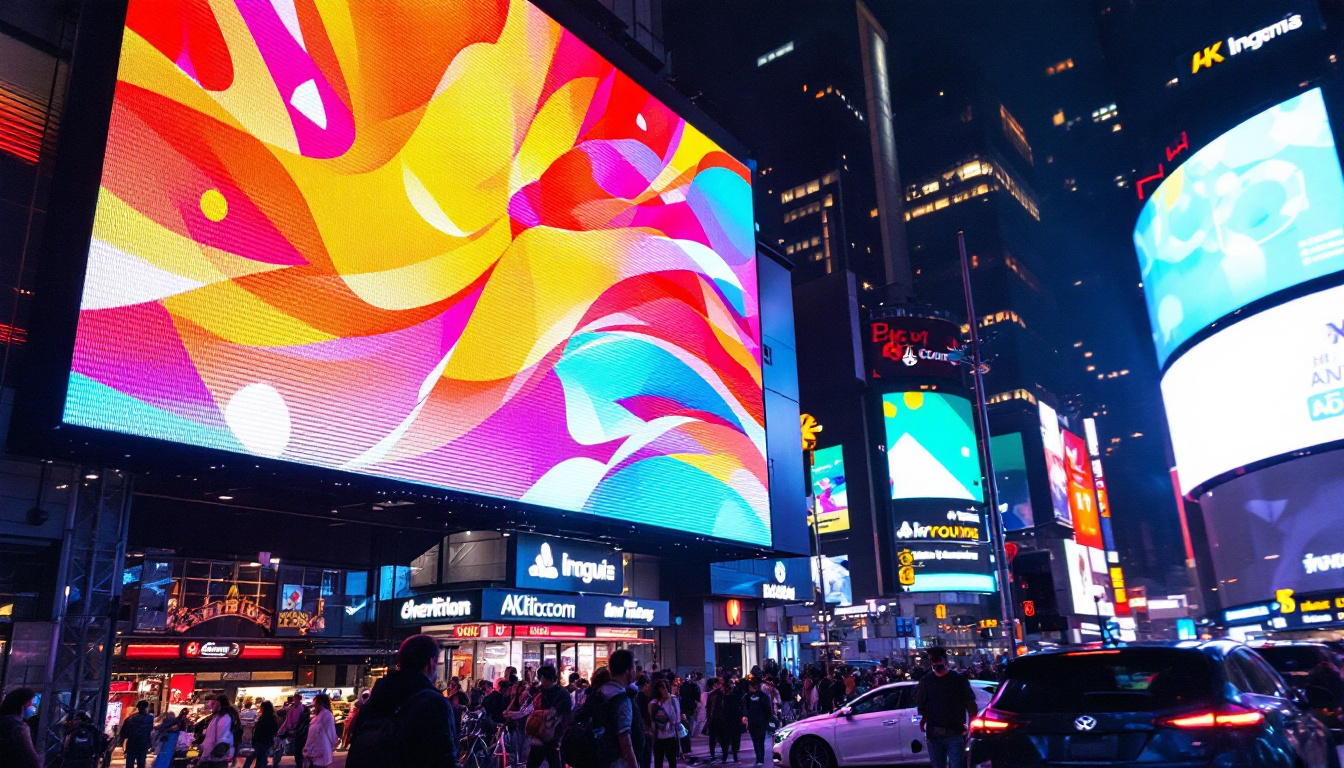In the modern world of air travel, efficiency and clarity are paramount. Airports are bustling hubs of activity, and the information displayed to passengers must be both accurate and easily digestible. This is where LED displays come into play. The evolution of LED technology has transformed the way information is communicated in airports, enhancing the travel experience for millions of passengers every day. This article delves into the intricacies of LED displays in airports, exploring their functionality, benefits, and the future of this technology.
Understanding LED Displays
LED, or Light Emitting Diode, displays have become a staple in various industries, including transportation. These displays utilize semiconductor technology to emit light when an electric current passes through them. This technology is not only energy-efficient but also offers superior brightness and contrast compared to traditional display methods. The longevity of LED displays is another significant advantage, with many units lasting tens of thousands of hours, reducing the need for frequent replacements and maintenance, which can be a considerable cost-saving for businesses.
How LED Displays Work
At the core of LED technology is the diode itself, which is a small electronic component that allows current to flow in one direction. When the diode is energized, it emits light. In LED displays, multiple diodes are arranged in a grid to create images and text. The combination of red, green, and blue diodes allows for a full spectrum of colors, enabling the display of vibrant graphics and clear text. This RGB configuration is crucial for creating realistic images and videos, making LED displays a preferred choice for dynamic content. Furthermore, advancements in LED technology have led to the development of high-definition displays that can render intricate details and subtle color variations, enhancing the viewer’s experience.
LED displays can be categorized into two main types: direct view and backlit. Direct view displays are made up of individual LED modules that form the entire screen, while backlit displays use LEDs to illuminate an LCD panel. Both types have their unique advantages, but direct view displays are particularly favored for their brightness and visibility in various lighting conditions. Additionally, the flexibility of direct view LED displays allows them to be configured in various shapes and sizes, making them suitable for everything from massive outdoor billboards to intricate indoor installations.
Types of LED Displays Used in Airports
Airports employ a variety of LED display types to convey information effectively. The most common types include:
- Flight Information Displays (FIDs): These screens provide real-time updates on flight arrivals, departures, and gate changes. They are typically located in high-traffic areas such as departure lounges and arrival halls. The integration of FIDs with flight tracking systems ensures that the information displayed is accurate and timely, which is crucial for passenger satisfaction and airport efficiency.
- Wayfinding Displays: These displays assist passengers in navigating the airport. They often include interactive maps, directional arrows, and information about amenities. Some airports have even implemented touch-screen technology, allowing travelers to search for specific locations or services, such as lounges, restaurants, and shops, enhancing the overall travel experience.
- advertising displays: Airports also utilize LED screens for advertising purposes. These displays can showcase promotions, services, and products available within the airport. The strategic placement of these advertisements in high-visibility areas can significantly increase engagement, providing brands with a unique opportunity to reach a captive audience.
In addition to these common types, airports are increasingly adopting innovative LED solutions such as immersive digital art installations and large-scale video walls. These installations not only serve functional purposes but also enhance the aesthetic appeal of the airport environment, creating a more engaging atmosphere for travelers. As technology continues to evolve, we can expect to see even more creative applications of LED displays in airports, further transforming the way information is communicated and enhancing the overall passenger experience.
The Benefits of LED Displays in Airports
The adoption of LED displays in airports has brought about numerous advantages, enhancing both operational efficiency and passenger experience. Here are some of the key benefits:
Enhanced Visibility and Clarity
One of the most significant advantages of LED displays is their brightness and clarity. Unlike traditional LCD screens, LED displays can be easily viewed in various lighting conditions, whether it’s the bright sunlight streaming through terminal windows or the dim lighting of a boarding gate. This ensures that passengers can receive critical information without straining their eyes. Additionally, the vibrant colors and high contrast ratios of LED displays make it easier for travelers to quickly identify important messages, such as flight changes or gate information, reducing the likelihood of missed flights.
Energy Efficiency
LED technology is known for its energy efficiency. These displays consume significantly less power compared to older technologies, leading to reduced operational costs for airports. This energy efficiency also aligns with global sustainability goals, making airports more environmentally friendly. Furthermore, many airports are now integrating solar panels to power these LED systems, creating a self-sustaining energy model that not only cuts costs but also promotes a greener image to travelers and stakeholders alike.
Durability and Longevity
LED displays are built to withstand the rigors of high-traffic environments. They are more durable than traditional displays, with a longer lifespan and reduced maintenance needs. This reliability is crucial in an airport setting, where downtime can lead to confusion and operational delays. Moreover, the robust construction of LED displays means they are less susceptible to damage from impacts or environmental factors, such as humidity and temperature fluctuations, which are common in busy terminals. This resilience ensures that airports can maintain a consistent flow of information to passengers, enhancing overall operational stability.
Dynamic Content and Real-Time Updates
Another compelling benefit of LED displays is their ability to showcase dynamic content and real-time updates. Airports can utilize these screens to display not only flight information but also advertising, wayfinding assistance, and even local news or weather updates. This flexibility allows airports to engage passengers with relevant content, enhancing their overall experience while waiting for flights. For instance, during peak travel seasons, airports can quickly update displays to reflect changes in security wait times or provide information about nearby amenities, helping travelers make informed decisions and reducing stress.
Improved Passenger Engagement
LED displays also play a vital role in improving passenger engagement. By incorporating interactive features, such as touch screens or QR code scanning, airports can facilitate a more personalized experience. Passengers can access flight details, terminal maps, and even dining options at their fingertips, making their journey smoother and more enjoyable. Additionally, the use of LED displays for entertainment purposes, such as showcasing art installations or live performances, can transform the airport environment into a more welcoming and engaging space, turning layovers into opportunities for exploration and enjoyment.
Implementing LED Displays in Airports
The implementation of LED displays in airports involves careful planning and consideration. Airports must assess their specific needs, the types of information to be displayed, and the locations of the screens. Here are some key factors to consider:
Design and Placement
Effective design and strategic placement of LED displays are essential for maximizing their impact. Displays should be positioned in high-visibility areas where passengers naturally congregate. Additionally, the design should be intuitive, ensuring that information is presented clearly and concisely.
Integration with Existing Systems
For LED displays to be effective, they must be integrated with existing airport information systems. This integration allows for real-time updates to be displayed, ensuring that passengers receive the most current information. Airports often utilize centralized management systems to control multiple displays from a single interface, streamlining operations.
Content Management
Content management is another critical aspect of implementing LED displays. Airports must ensure that the information displayed is accurate, timely, and relevant. This often involves collaboration between various departments, including operations, marketing, and customer service, to create a cohesive communication strategy.
Challenges and Considerations
While LED displays offer numerous benefits, there are also challenges that airports must navigate. Understanding these challenges can help in creating effective solutions.
Cost of Implementation
One of the primary challenges in adopting LED technology is the initial cost of implementation. High-quality LED displays can be expensive, and airports must weigh the upfront investment against the long-term benefits. Budget constraints can limit the number of displays installed, potentially affecting the overall passenger experience.
Technological Advancements
The rapid pace of technological advancements in LED displays can pose challenges for airports. New features and capabilities are constantly being developed, which may render older displays obsolete. Airports must consider the longevity of their investment and the potential need for future upgrades.
Maintenance and Support
While LED displays are generally low-maintenance, they still require regular upkeep to ensure optimal performance. Airports must establish a maintenance schedule and have a support team in place to address any technical issues that may arise. This ongoing commitment can add to operational costs but is essential for maintaining the reliability of the displays.
The Future of LED Displays in Airports
The future of LED displays in airports looks promising, with ongoing innovations and improvements on the horizon. As technology continues to evolve, airports can expect to see enhanced functionalities and capabilities.
Smart Displays and Interactivity
One of the most exciting developments in LED technology is the shift towards smart displays. These displays can interact with passengers through touchscreens, enabling them to access personalized information, such as flight updates and airport services. This interactivity enhances the passenger experience and allows for a more tailored approach to communication.
Integration with Mobile Technology
As mobile technology continues to advance, airports are exploring ways to integrate LED displays with passengers’ smartphones. This could involve displaying personalized notifications on LED screens based on a passenger’s itinerary or location within the airport. Such integration would create a seamless travel experience, allowing passengers to receive real-time updates directly related to their journey.
Enhanced Data Analytics
The future of LED displays also lies in data analytics. By collecting and analyzing data on passenger behavior and preferences, airports can optimize the content displayed on LED screens. This data-driven approach can lead to more effective communication strategies, ultimately improving the overall travel experience.
Conclusion
LED displays have revolutionized the way information is communicated in airports, providing numerous benefits that enhance both operational efficiency and passenger experience. From improved visibility and energy efficiency to the potential for smart, interactive displays, the future of LED technology in airports is bright. As airports continue to adopt and innovate with LED displays, they will play a crucial role in shaping the future of air travel.
In conclusion, the integration of LED displays in airports is not just a trend; it is a necessary evolution in the way information is shared in our increasingly fast-paced world. As technology continues to advance, airports that embrace these innovations will undoubtedly lead the way in providing a seamless and enjoyable travel experience for passengers around the globe.
Discover LumenMatrix LED Display Solutions
As you envision the future of air travel and the role LED displays play in enhancing passenger experiences, consider the innovative solutions offered by LumenMatrix. With a commitment to revolutionizing visual communication, LumenMatrix provides a wide array of LED display modules, from Indoor and Outdoor LED Wall Displays to specialized options like Vehicle, Sports, and Floor LED Displays. Whether you’re looking to create a dynamic advertising platform or an interactive wayfinding system, LumenMatrix has the technology to bring your vision to life. Check out LumenMatrix LED Display Solutions today and take the first step towards transforming your airport’s communication strategy.































